In 2005 the rEvo rebreather was produced in numbers in Belgium. the rEvo rebreather has, after much research, developed into a very innovative rebreather that is used all over the world. In the very beginning the following article came about thanks to Paul Raymakers owner of rEvo. Today the rEvo is a range of rebreathers that can be further studied on the beautiful rEvo website. In this 2006 article Paul elaborates on the design criteria that formed the basis for the rEvo line of rebreathers.
rEvo rebreather
Tekst P. Raymakers
October 2006
General
The rEvo is a closed circuit rebreather with back-mounted counterlungs. It has an inhale and an exhale counterlung which are protected by a liner completely surrounded by a stainless steel case.
The rEvo has two scrubbers (cartridges filled with sofnolime) positioned in line connected to a quick swap system, and steel two 3 liter cylinders, one for oxygen and one for diluent.
The rEvo is available in two versions, the mCCR and the eCCR.
The mCCR has an 0.0035 orifice and a fixed pressure regulator (APR, absolute pressure regulator). In this system the PPO2 is monitored by a so called rEvodream (PO2 gauge with HUD) and a deco computer equipped with an Oxygen cell or two rEvodreams.
The eCCR has a hammerhead primary unit and a rEvodream which work independently.
The manual addition of oxygen or diluent can be done by pressing buttons integrated in the stainless steel case: so extra hoses at the front of the chest are not necessary.
The two parts of the backplate of the rEvo are positioned in the form of an angle and can be adjusted to the size of the diver to get a ‘best-fit’. A simple comfortable harness and a wing with an inflator connection integrated in the case make sure that the rebreather is perfectly fit at the back of the diver with a minimal resistance and drag.
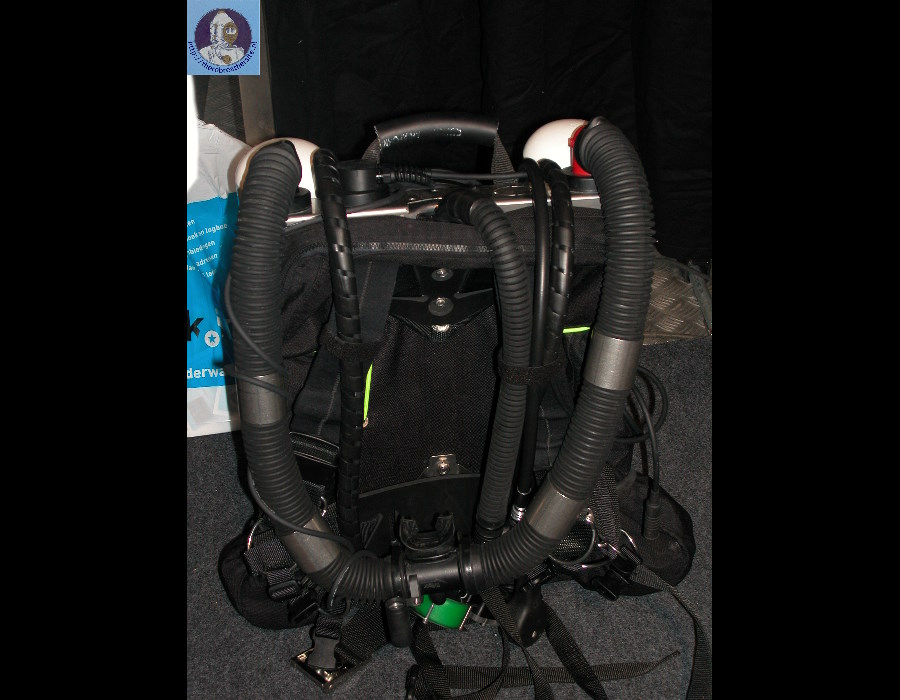
Breathing hose
The breathing hose is an original part of the standard Dräger Ray system. However the mouthpiece has been adjusted to make sure that it will open and close easy under all circumstances (very cold and very warm water temperatures). Necessary adjustable weights have been added to get the perfect trim for the breathing hose.
Instead of using a Ray mouthpiece an ordinary mouthpiece fastened by straps behind the head will work fine. Also a full face mask will do the trick. These last two alternatives prevent an unconscious diver to inhale water.
The mouthpiece offers the opportunity to click on the HUD (see later).
Counter lungs
Both counter lungs are made of PU material and the seams are high frequency welded. This combination guarantees a kind of an indestructible breathing system.
The hoses for the manual addition of the two breathing gasses, the ADV, the orifice for the mCCR and the solenoid for the eCCR you’ll all find in the exhale counter lung. Between the inhale and exhale lung the two scrubbers are mounted in line. Below the second scrubber, on the side of the inhale lung the O2 cells are connected, in a dry as possible area because of the flow of the warm gasses out of the second scrubber.
An anti-collapse hose, a condensation absorber and an overpressure valve are assembled in the inhalation counter lung.
Both counter lungs are protected by a rubber liner and placed in an as thin as possible stainless steel case that can be shaped into the best fit for the divers back and shoulders.
The connections between the counter lungs and the scrubber cartridges have the same full diameter of the cartridges: 154mm. This means that there are no more restrictions in the gas flow anywhere at the inside of the stainless steel case with the result of a very low breathing resistance in normal diving position.

Harness, Wing and Backplate
The standard harness with a turn link has been assembled on a two-part back plate: by a special shoulder part specially attached in an angle at the top of the rebreather the rebreather can be mounted following the build of the back and shoulders of the diver. The shoulder straps of the harness are attached to this special shoulder part.
The supporting part of the harness at the small of the back of the diver can be adjusted to the length of the diver. Following the bands of the harness the rebreather can be fitted to the belly of the diver.
As well as on the shoulder as at the lumbar area of a rubber protection plate is attached by the harness.
The assembled wing is mounted in a way that the connection to the inflator is integrated in the stainless steel case.
The construction of the two-part back plate, placed under an angle as well as the thin stainless steel case and the integrated connection of the wing make it possible that the rebreather can be fitted to the diver in the best streamlined way.
Also the perfect fit makes sure that hydrostatic differences in pressure are neglect able: the counter lung is kind of glued to the back of the diver. Another guarantee the WOB (work of breathing) in normal diving position will be minimal.
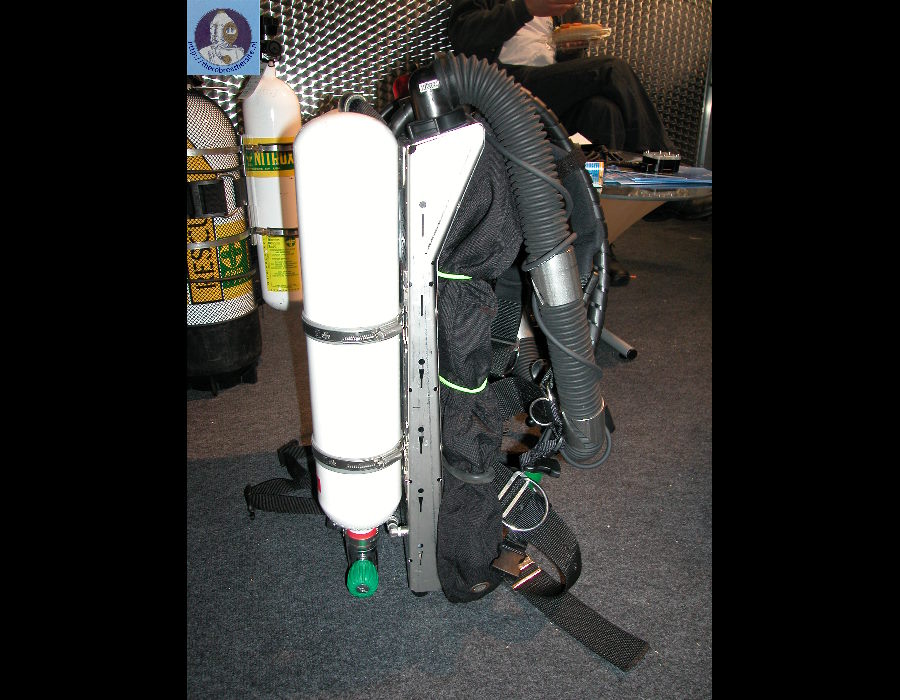
Scrubbers
In the rEvo you’ll find an unique scrubber system, placed in line: both contain about 1.4 kg of sofnolime and are attached to each other by holes in the scrubber lid.
In practice the scrubber will be absorbed at first at the entrance of the container: at the exit the sofnolime will never be absorbed because the material will be replaced in time to prevent diving with a no longer absorbing scrubber. However, it has never been known how much of the scrubber has been used: a fact is that always a sufficient amount of unused absorbent will be thrown away.
The system of two scrubbers, placed in line, has a favorable effect in using the absorbent as long as the correct working method is applied.
The filled cartridges can be detached in a simple way: with just one screw the lid can be removed to detach the cartridges form the scrubber container. This simplifies the next working order: you start with two fresh filled cartridges: number 1 will be placed above the exhale counter lung (at the top of the rebreather), number 2 above the inhale lung (the numbers are written on the cartridges so no mistake can be made).
After a certain period of diving time (depending on the circumstances, see later) a next working order will be applied: cartridge number 1 (exhale side) will be removed and emptied, cartridge 2 will be mounted above the exhale counter lung and cassette 1 (with fresh sofnolime) will be placed above the inhale lung: after that you’ll have the same diving time as before followed by a new working cartridge exchange cycle and so on.
The consequence of this working cycle is that you’ll always get rid off half of the sofnolime, the part that’s mostly absorbed (the absorbent that was attached to the exhale counter lung, the lung where the exhaled gas will be pass first) The lesser or almost not used absorbent will be placed at the beginning of the breathing cycle, the place where the exhaled gas will pass first. Here, the absorbent will absorb the CO2 easily as the % of the CO2 will still be high (and will be almost completely absorbed): the second (fresh) scrubber will absorb the possible rest of the low % CO2.
From experience I can tell that the procedure of systematically getting rid of half of the absorbent (the most absorbed part) and after that get the next part absorbed, the duration time can be expanded of the sofnolime can be expanded by 50%.
But by holding on to the same duration times of an equally same size one-part scrubber the double scrubber system offers much more safety
Practically seen: a quit dive, warm water and not to deep gives you 150 minutes per cycle (about 1.8h/kg absorbent) never gave me any problem. Heavier circumstances: cold or deep: 120 minutes per cycle.
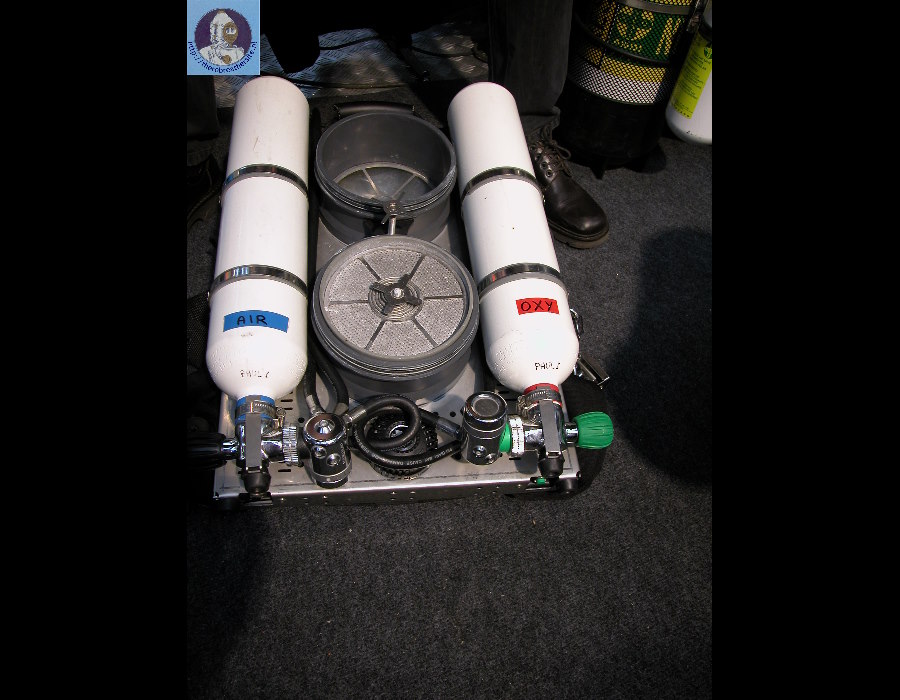
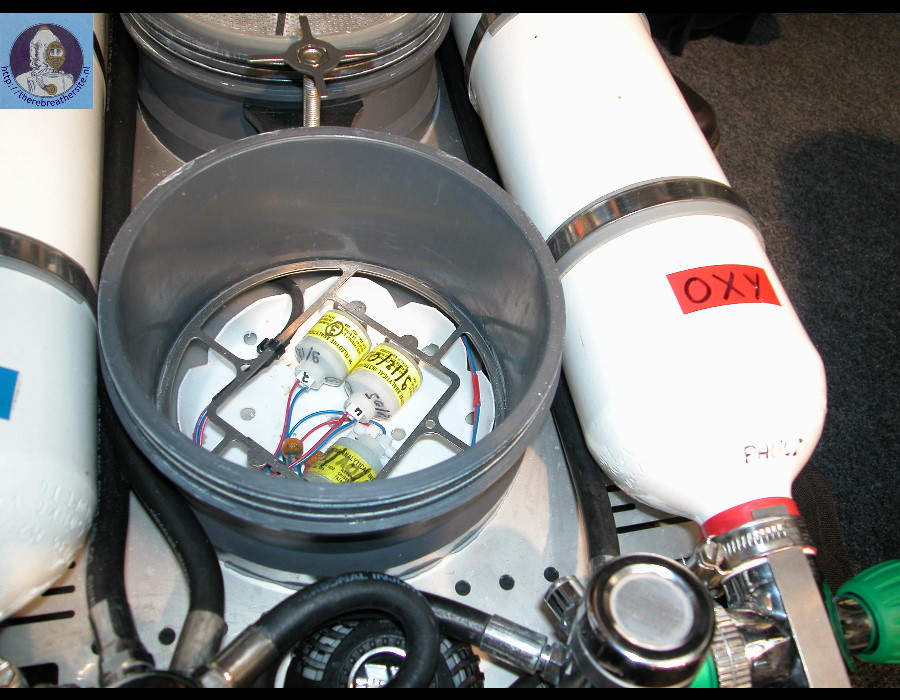
Cylinders with fast mounting system
The cylinders will be mounted on the case by a fast fix system: The positioning of the valve of the cylinder and the inflators will be immediately correct.
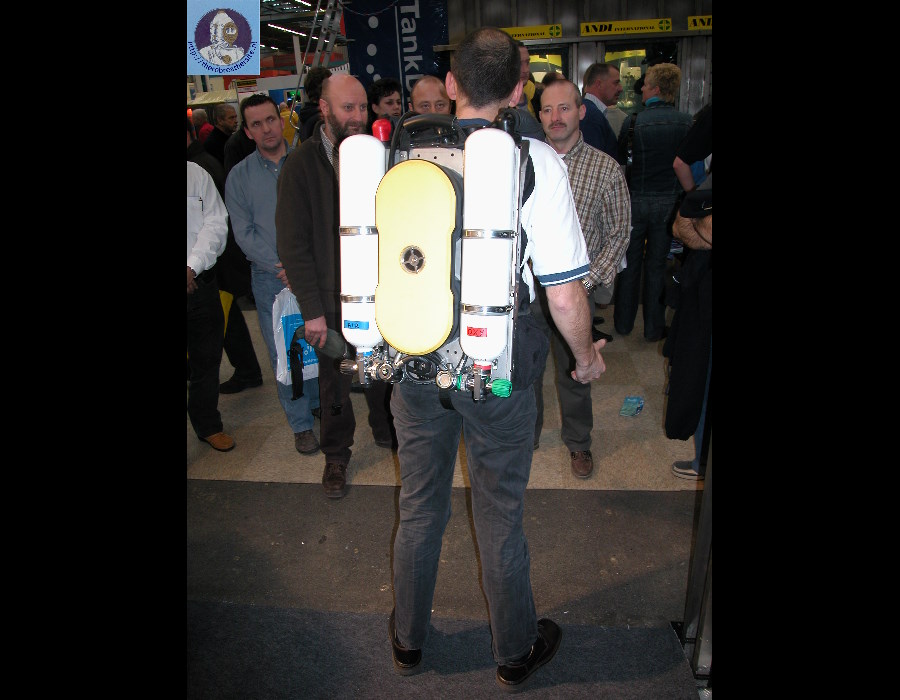
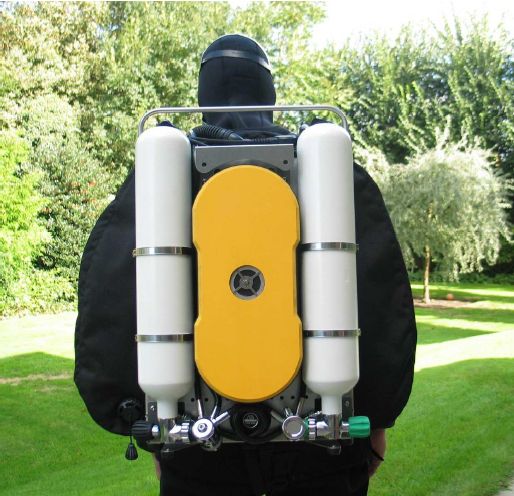
Stainless steel carry handle
At the top of the rebreather you’ll find a standard full breath stainless steel carry handle: not only handy if needed to get the rebreather out of the water by two persons, but also to protect the plastic connections of the breathing hose.
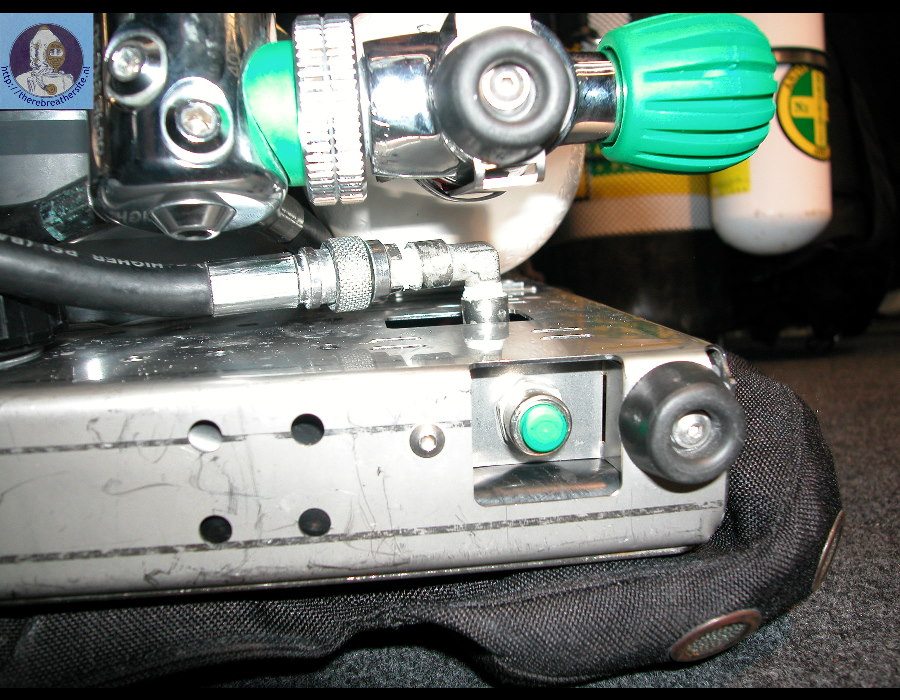
Manual addition of oxygen and diluent
The buttons for manual addition of dil and oxygen are integrated in the bottom of the stainless steel case so they can always be found easily (they can’t be moved because they are not attached to a dangling middle pressure hose). This also means that the diver has free space in front of him. The applied valves are equipped with extra spring power to prevent the valves getting blocked in open position.
Choice of the gas system; constant mass flow (cmf) or Hammerhead (HH)
There are two versions of the rEvo: a manual regulated rebreather with constant oxygen flow and an electronic controlled system.
Manual regulated: in this version the first stage of the oxygen system is blocked so it will not increase its pressure with increasing depth: in the exhale counter lung a 0.0035 diameter orifice is attached to the pressure hose: at the fixed set pressure of 11 bar the oxygen flow will be about 0.75 ltr/min: this will be enough for a diver in rest.
During the dive the diver constantly monitors the partial oxygen pressure by two independent systems (see later) and adds oxygen when needed by the at the bottom of the case integrated pressure buttons (if necessary dil if the PPO2 reached too high).
In the electronically controlled version the orifice in the exhale lung is replaced by an electronically regulated valve (solenoid): in this version the regulator on the oxygen side is an ordinary (oxygen compatible) regulator.
The valve is controlled by the hammerhead primary module of the firm Juergenson Marine. This module also contains a full blown deco-computer, even with trimix algotithm on request.
Both versions of the rEvo are equipped with an ADV on the diluent side.
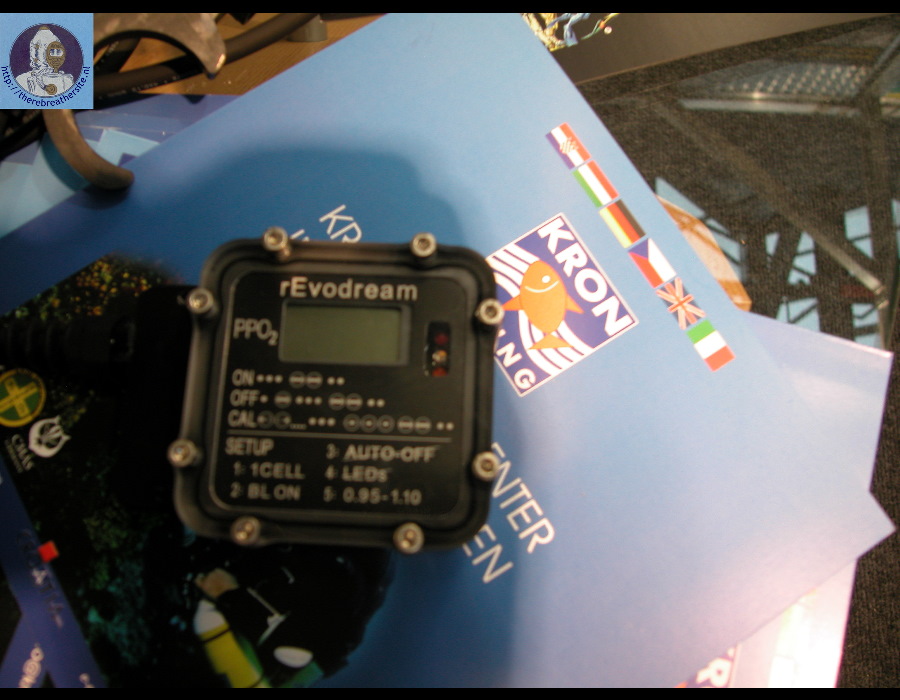
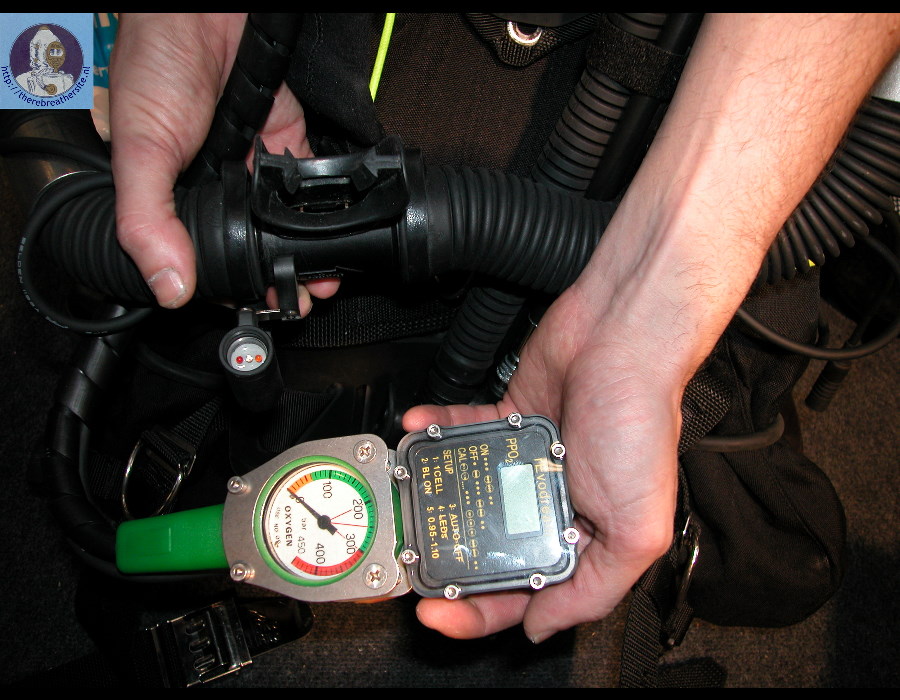
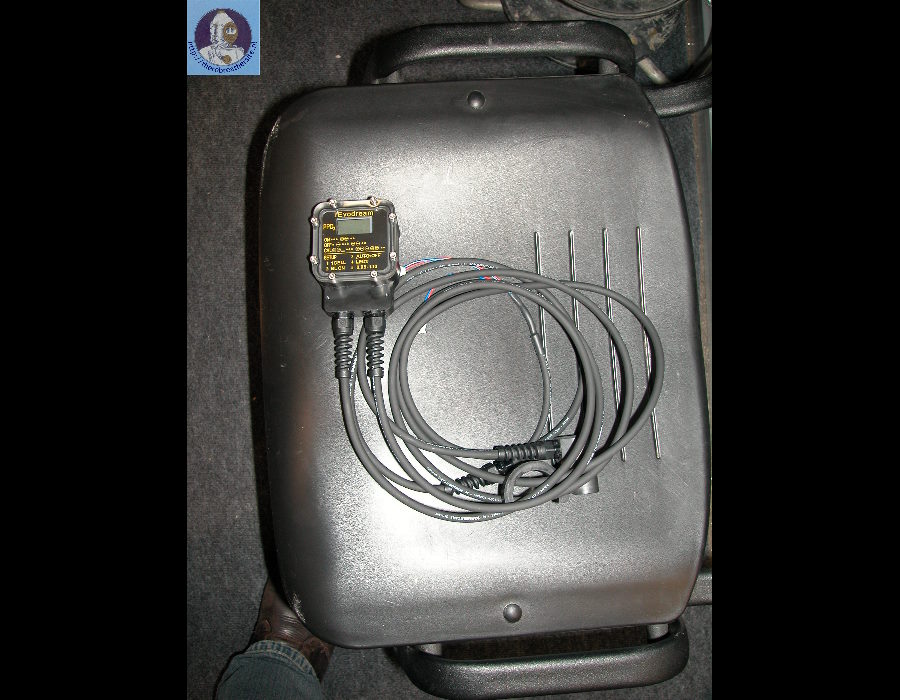
Upright position
The rebreather can be put aside in upright position as on both cylinder valves rubber supporting parts are attached, likewise at the bottom of the case.
PPO2 monitoring
For continuous monitoring the PPO2 the rEvo is equipped with one or two rEvodreams: a rEvodream contains a LCD console on which the PPO2 is displayed and a HUD which clearly shows an indication of the PPO2 range by an orange, green or red led. The LCD console is attached to a pressure gauge as during the dive all necessary information will be displayed on the HUD: you only look at the LCD console to compare the measured values with a second independent monitoring system or during the calibration process. This second independent monitoring system could be a deco-computer equipped with an independent oxygen cell or a HH primary, that in the eCCR version also takes control of the solenoid, or another rEvodream if neither deco-computer or HH are present. In the case of a second rEvodream 1 console is attached to each pressure gauge and two HUDs will be placed next to each other on top of the mouth piece.
Alternatives:
There is also a ‘travel’ version with a case completely made of titanium and cylinders of carbon in stead of the steel ones (in both cases 2 times 3 liters).
The complete rEvo CT (Carbon Titan) weights about 21 kilos, the standard version 28 kilos.
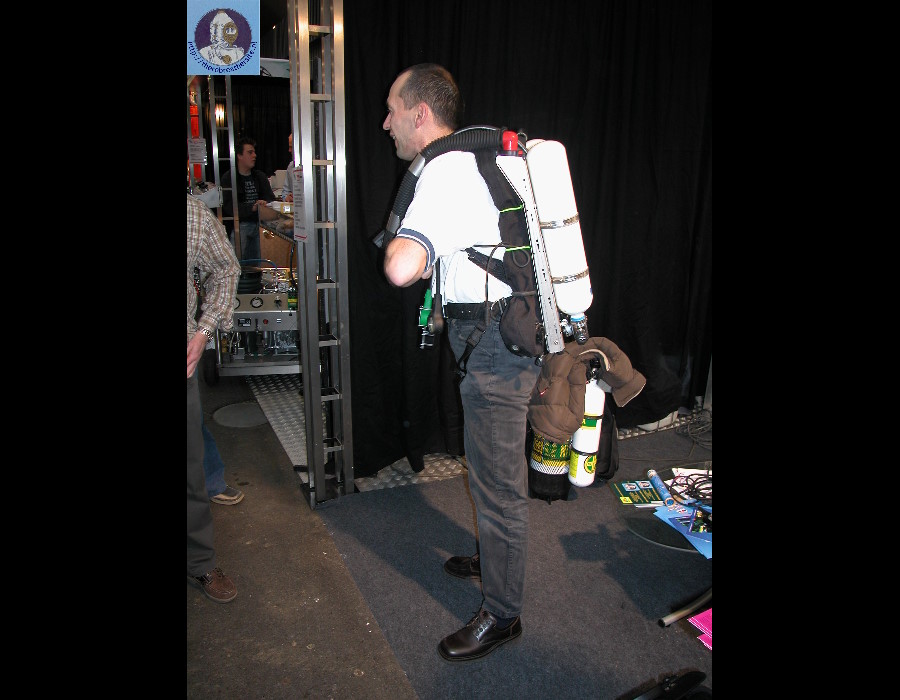
The unit does not stand on the valves anymore. From now on (rEvo II) the unit is only delivered in manual controlled version equipped with two rEvodreams. We will wait a while using the Hammerhead.
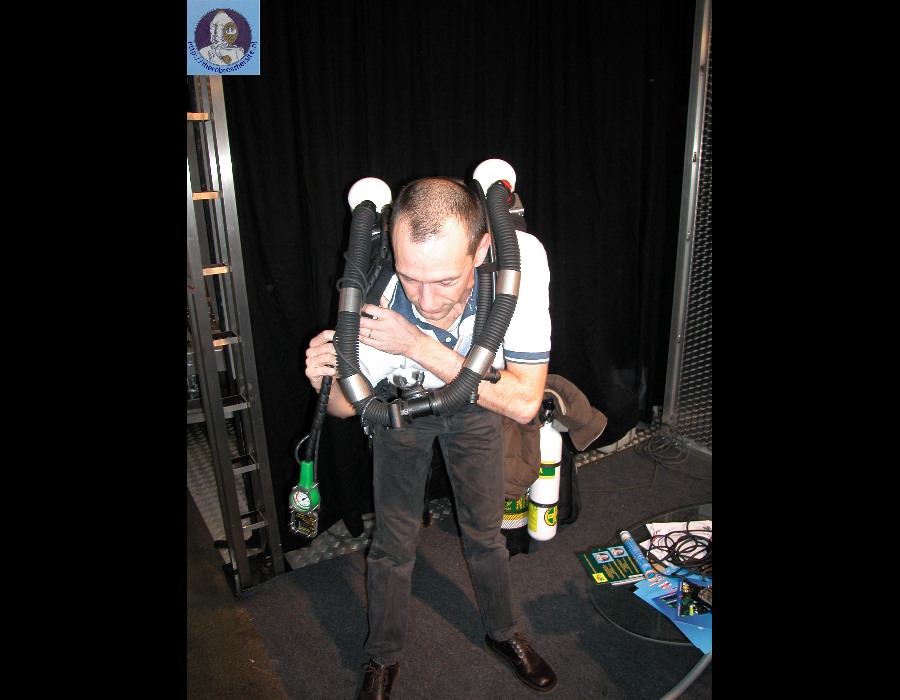
Paul, thanks for contributing to my website!
De meest recente versie van de rEvo standard, de mini en de mini FT kan op de website van rEvo worden gevonden. Er is tevens een uitgebreide bibliotheek met interessante artikelen over rebreather onderwerpen. Je vind de website hier
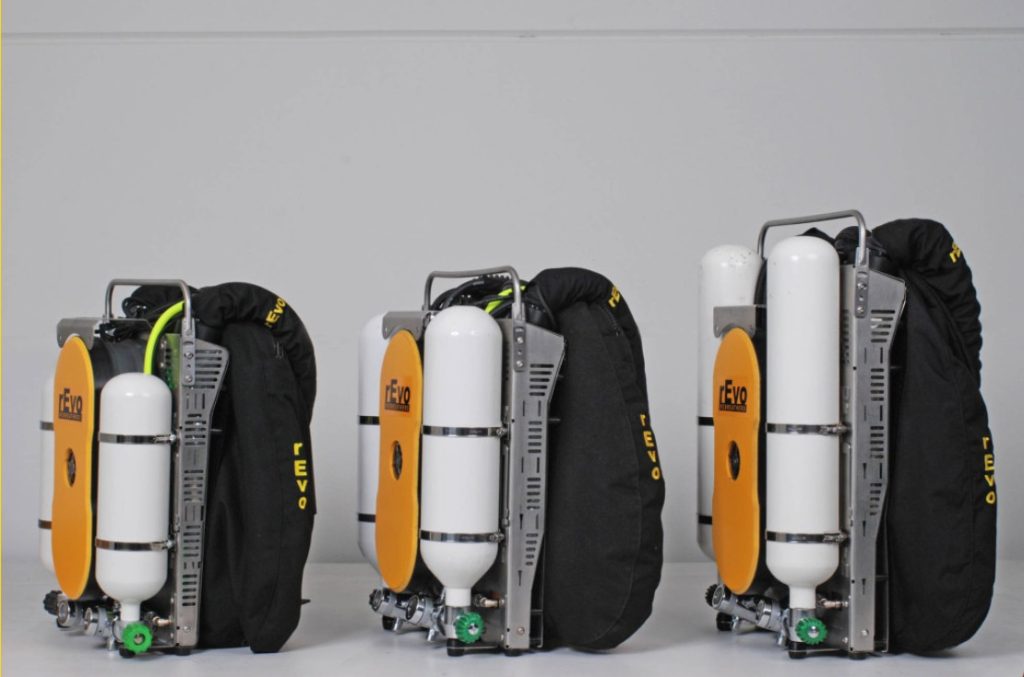
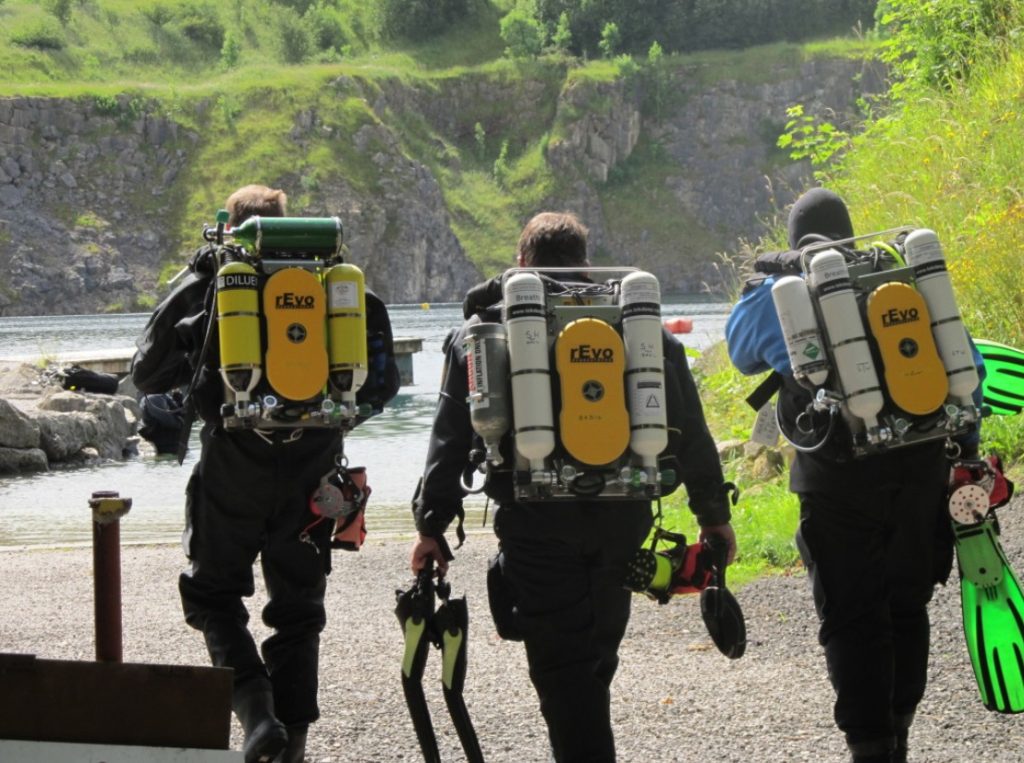
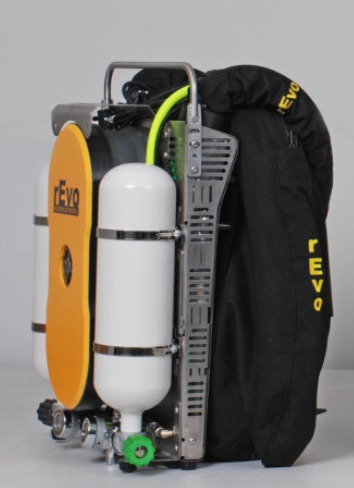

Therebreathersite was founded by Jan Willem Bech in 1999. After a diving career of many years, he decided to start technical diving in 1999. He immediately noticed that at that time there was almost no website that contained the history of closed breathing systems. The start for the website led to a huge collection that offered about 1,300 pages of information until 2019. In 2019, a fresh start was made with the website now freely available online for everyone. Therebreathersite is a source of information for divers, researchers, technicians and students. I hope you enjoy browsing the content!
